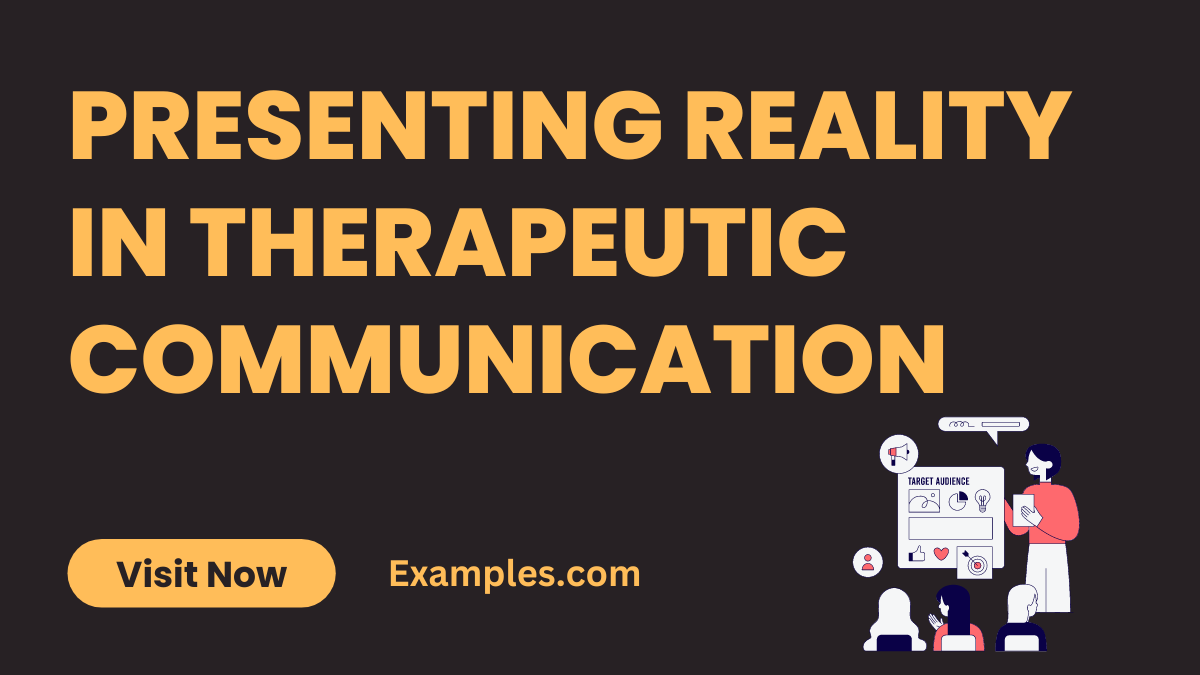19+ Presenting Reality in Therapeutic Communication Examples
Embark on a transformative journey of transparent dialogue with our complete guide on Presenting Reality. Explore nuanced examples and valuable Communication Examples to master the art of delivering honest and empathetic messages. This resource is designed to enhance your therapeutic skills, providing insights and strategies for fostering authentic connections in the realm of mental health and well-being.
What is Presenting Reality in Therapeutic Communication?
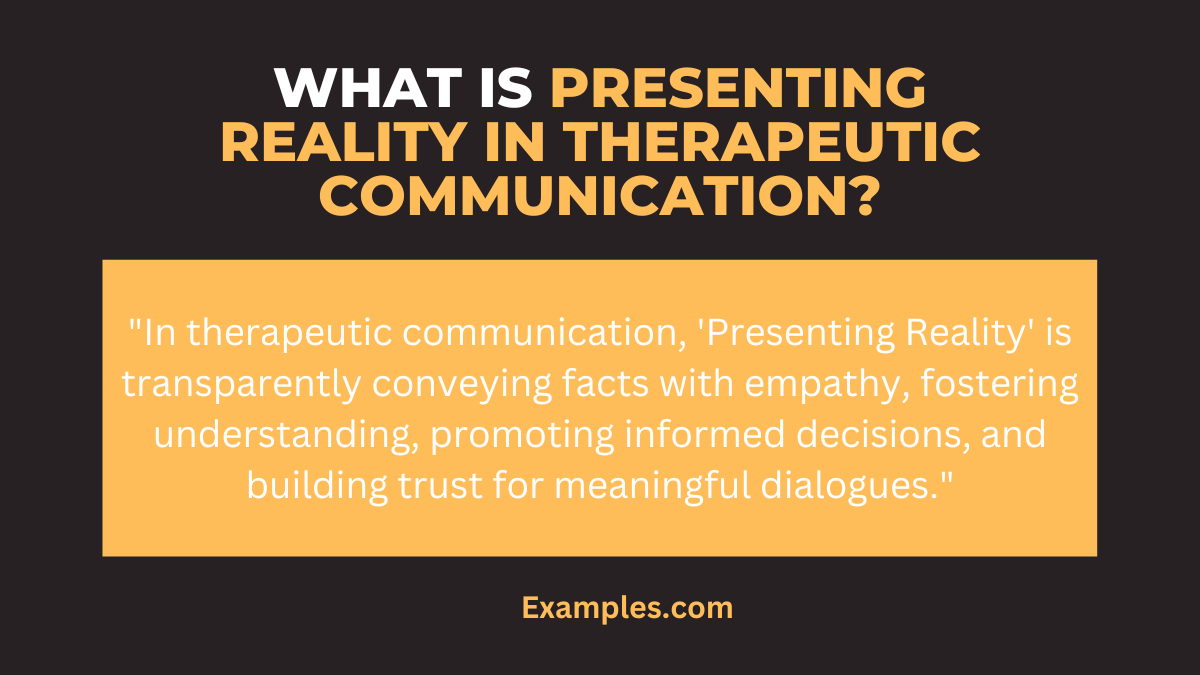
In therapeutic communication, “Presenting Reality” involves transparently conveying facts, situations, and truths with empathy. This approach aims to foster understanding by openly discussing and acknowledging the actualities of a situation. Healthcare professionals use this technique to provide clarity, promote informed decision-making, and build trust with individuals under their care. Essentially, it’s the honest presentation of reality to facilitate meaningful and supportive dialogues in the therapeutic setting.
What is the Best Example of Presenting Reality in Therapeutic Communication?
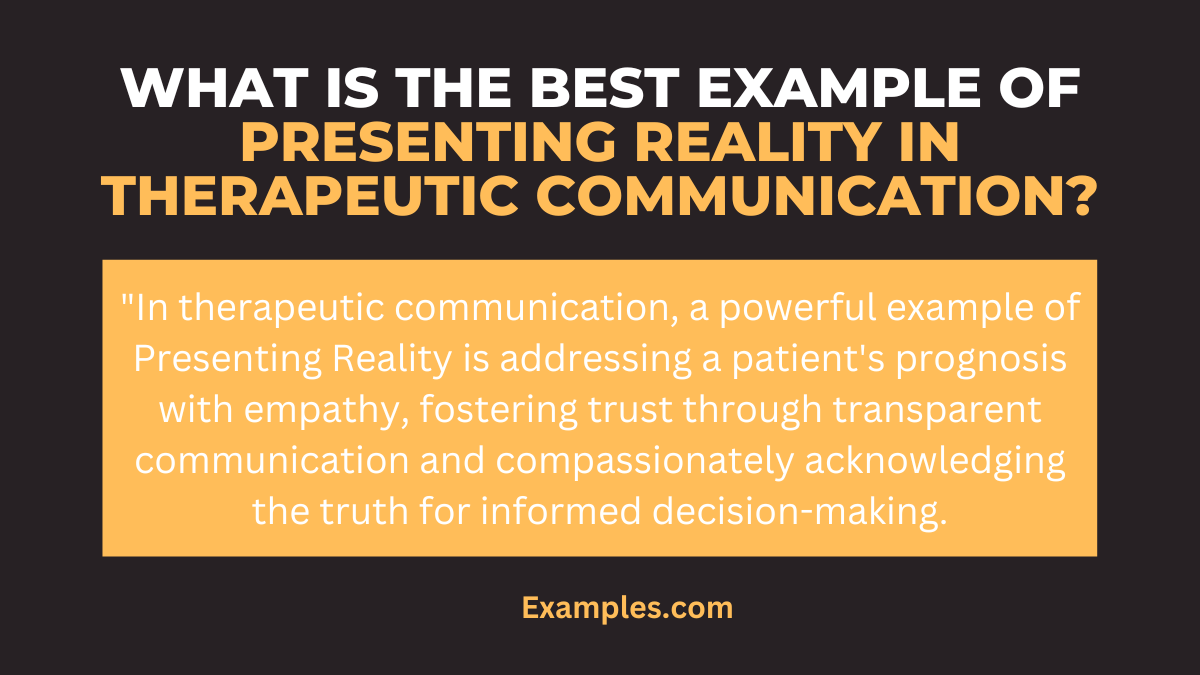
In the realm of therapeutic communication, a powerful example of Presenting Reality involves a healthcare professional addressing a patient’s prognosis. With empathy, they might say, “It’s important to discuss the reality of your health. While the situation is challenging, understanding it allows us to make informed decisions and plan for the best possible care.” This example demonstrates transparent communication, acknowledging the truth with compassion, fostering trust, and supporting the patient’s journey.
20 Presenting Reality in Therapeutic Communication Examples
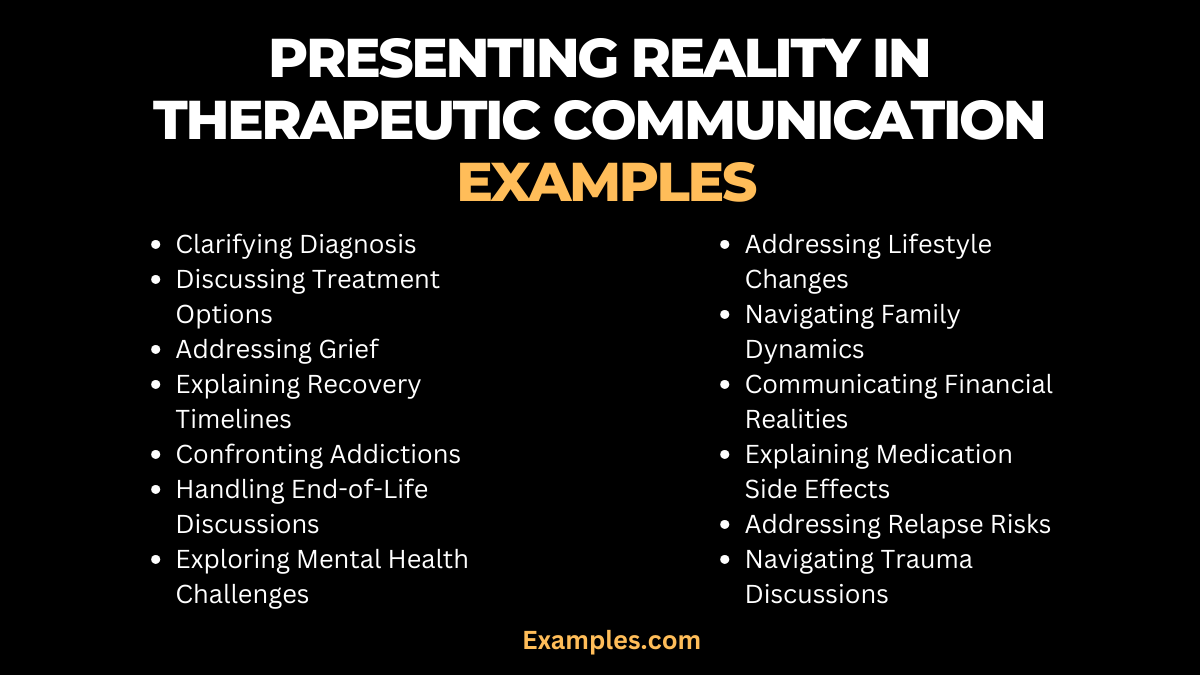
Explore these impactful examples that exemplify the art of Presenting Reality in therapeutic communication. Each scenario is crafted to enhance your understanding and proficiency in delivering transparent and empathetic messages.
- Clarifying Diagnosis: “Clearly explain the diagnosis, ensuring the individual understands the medical reality they are facing.”
- Discussing Treatment Options: “Present various treatment options, outlining the potential benefits and challenges to empower informed decisions.”
- Addressing Grief: “Acknowledge grief with compassion, discussing the reality of loss and fostering a supportive environment.”
- Explaining Recovery Timelines: “Communicate realistic recovery timelines, setting expectations for a patient’s healing journey.”
- Confronting Addictions: “Present the reality of addiction consequences, emphasizing the importance of seeking help for recovery.”
- Handling End-of-Life Discussions: “Navigate end-of-life discussions with sensitivity, ensuring a compassionate and honest approach.”
- Exploring Mental Health Challenges: “Discuss mental health challenges openly, reducing stigma and promoting understanding.”
- Addressing Lifestyle Changes: “Present the necessity of lifestyle changes, supporting individuals in adopting healthier habits.”
- Navigating Family Dynamics: “Acknowledge family dynamics, discussing the impact on mental health and fostering open communication.”
- Communicating Financial Realities: “Transparently discuss financial aspects, helping individuals plan for necessary adjustments.”
- Explaining Medication Side Effects: “Clearly communicate potential medication side effects, enabling individuals to make informed choices.”
- Addressing Relapse Risks: “Discuss relapse risks with empathy, empowering individuals to create effective relapse prevention strategies.”
- Navigating Trauma Discussions: “Present the reality of trauma with care, creating a safe space for individuals to share and heal.”
- Discussing Chronic Illness Management: “Transparently discuss managing chronic illnesses, providing guidance for a proactive approach.”
- Explaining Physical Limitations: “Present physical limitations with empathy, encouraging adaptive strategies for improved quality of life.”
- Handling Critical Incidents: “Address critical incidents truthfully, supporting individuals in processing and coping with the reality.”
- Discussing Caregiver Challenges: “Transparently address caregiver challenges, offering resources and support for their well-being.”
- Navigating Substance Abuse Treatment: “Present the realities of substance abuse treatment, emphasizing the importance of a comprehensive approach.”
- Explaining Medical Procedures: “Transparently explain medical procedures, ensuring individuals feel informed and involved in their healthcare.”
- Addressing Self-Harm Concerns: “Discuss self-harm concerns with empathy, creating a non-judgmental space for open dialogue and support.”
Presenting Reality in Therapeutic Communication in Nursing Examples
Explore examples tailored for nursing professionals, focusing on transparent communication to foster trust and understanding in patient interactions.
- Delivering Postoperative Realities: Discuss postoperative challenges openly, preparing patients for the realities of recovery and promoting a proactive mindset.
- Addressing Medication Limitations: Clearly communicate medication limitations, ensuring patients are informed and engaged in their treatment journey.
- Navigating End-of-Life Conversations: Approach end-of-life discussions with empathy, fostering a compassionate environment for patients and their families.
- Explaining Rehabilitation Expectations: Present realistic rehabilitation expectations, setting achievable goals for patients to actively participate in their recovery.
- Discussing Long-Term Care Plans: Transparently discuss long-term care plans, guiding patients in making informed decisions for ongoing health management.
- Addressing Chronic Pain Realities: Acknowledge chronic pain realities with compassion, offering support and coping strategies for patients.
- Communicating Terminal Diagnoses: Deliver terminal diagnoses with sensitivity, creating a space for patients to express emotions and preferences.
- Explaining Palliative Care Options: Present palliative care options openly, helping patients and families understand and navigate available supportive services.
- Discussing Lifestyle Modifications: Transparently discuss lifestyle modifications, empowering patients to actively participate in improving their overall well-being.
- Navigating Patient Concerns Post-Surgery: Address post-surgery concerns with empathy, providing clear information to alleviate anxieties and encourage healing.
Presenting Reality in Therapeutic Communication in Healthcare Examples
Explore examples tailored for broader healthcare settings, emphasizing transparent communication to build trust and enhance patient-provider relationships.
- Explaining Treatment Risks: Clearly communicate treatment risks, allowing patients to make informed decisions about their healthcare journey.
- Addressing Mental Health Realities: Discuss mental health realities openly, reducing stigma and promoting understanding for better therapeutic outcomes.
- Presenting Options in Emergency Situations: Present emergency situation options transparently, empowering patients and families to actively participate in decision-making.
- Communicating Chronic Disease Management: Transparently discuss chronic disease management, providing guidance for proactive and informed healthcare choices.
- Navigating Complex Medical Procedures: Explain complex medical procedures clearly, ensuring patients feel informed and involved in their treatment plans.
- Discussing Fertility Challenges: Address fertility challenges with sensitivity, offering support and presenting available options for family planning.
- Explaining Treatment Side Effects: Clearly communicate potential treatment side effects, allowing patients to make choices aligned with their comfort and preferences.
- Navigating Pediatric Care Realities: Present pediatric care realities with empathy, involving parents in discussions about their child’s health and well-being.
- Discussing Aging and Health: Transparently discuss aging and health concerns, guiding patients in planning for and managing the realities of aging.
- Addressing Healthcare Disparities: Acknowledge healthcare disparities with cultural sensitivity, fostering a more inclusive and equitable therapeutic environment.
What is the importance of Presenting Reality in Therapeutic Communication?
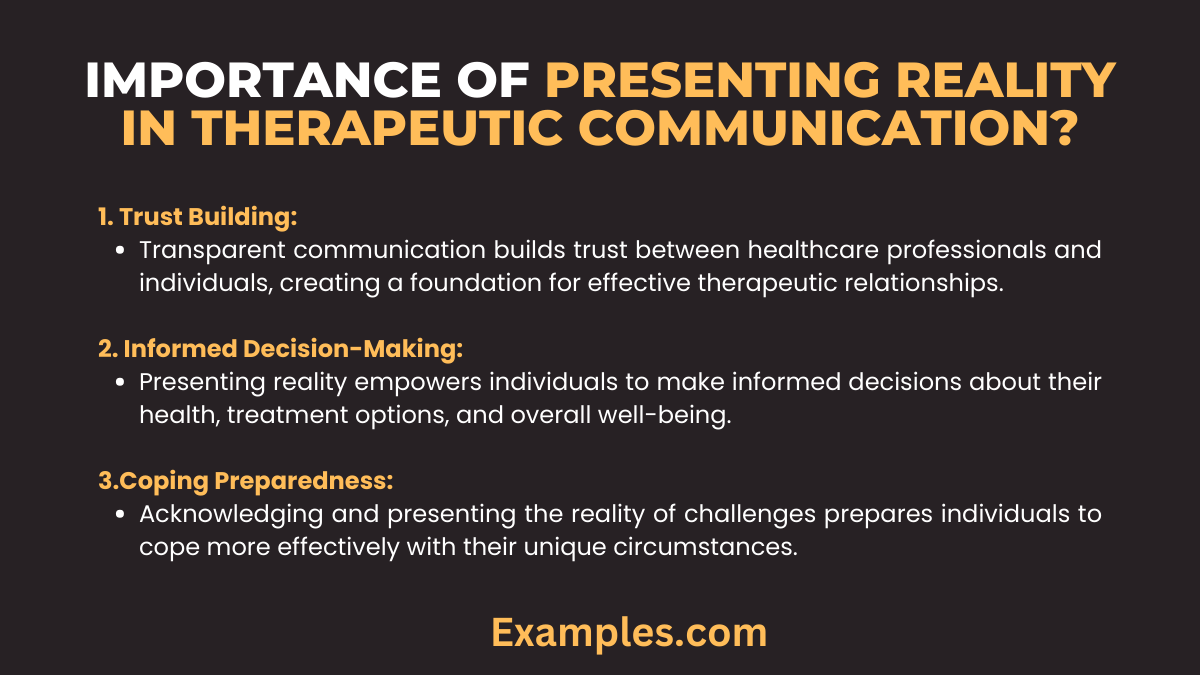
In therapeutic communication, presenting reality holds significant importance, fostering transparent and empathetic interactions. Here’s a concise guide highlighting its key facets:
- Trust Building: Transparent communication builds trust between healthcare professionals and individuals, creating a foundation for effective therapeutic relationships.
- Informed Decision-Making: Presenting reality empowers individuals to make informed decisions about their health, treatment options, and overall well-being.
- Coping Preparedness: Acknowledging and presenting the reality of challenges prepares individuals to cope more effectively with their unique circumstances.
- Supportive Environment: Transparent discussions create a supportive environment, encouraging individuals to express their thoughts and emotions openly.
- Reducing Anxiety: Addressing reality with empathy reduces anxiety, helping individuals navigate uncertainties and fears associated with their situation.
- Enhancing Understanding: Clear communication of reality enhances individuals’ understanding of their condition, treatment plans, and potential outcomes.
- Building Resilience: By presenting reality honestly, healthcare professionals contribute to building resilience in individuals, fostering a positive mindset.
- Promoting Collaboration: Transparent communication encourages collaboration between healthcare providers and individuals, ensuring active participation in the therapeutic process.
- Facilitating Emotional Expression: Acknowledging reality provides a safe space for individuals to express their emotions, contributing to emotional well-being.
- Encouraging Realistic Expectations: Presenting reality helps manage expectations realistically, aligning individuals’ perceptions with the actualities of their circumstances.
What are the factors for Presenting Reality in Therapeutic Communication?
Navigating the realm of therapeutic communication with transparency requires a nuanced understanding of essential factors. Enhance your skills in Presenting Reality by considering the following key elements:
- Empathetic Approach: Cultivate empathy to connect with individuals, ensuring the presentation of reality is grounded in understanding and compassion.
- Clear and Honest Communication: Prioritize clarity and honesty in conveying information, fostering trust through straightforward dialogue.
- Tailoring Information to Individual Needs: Recognize that individuals have varying levels of readiness for reality. Tailor the information to suit their unique needs and preferences.
- Cultural Sensitivity: Approach communication with cultural sensitivity, respecting diverse perspectives and adapting your approach accordingly.
- Timing and Readiness Assessment: Assess the individual’s readiness to receive information, considering their emotional state and overall preparedness.
- Collaborative Decision-Making: Foster a collaborative approach to decision-making, involving individuals in discussions about their care and treatment.
- Providing Adequate Support: Offer emotional and informational support, acknowledging that the reality presented may evoke various emotions and concerns.
- Addressing Potential Fears: Anticipate and address potential fears or anxieties associated with the presented reality, providing reassurance and guidance.
- Encouraging Questions and Dialogue: Create an open environment for questions and dialogue, promoting active participation and understanding.
- Offering Resources and Coping Strategies: Equip individuals with resources and coping strategies to navigate the presented reality effectively, empowering them in their journey.
In conclusion, mastering the art of Presenting Reality in therapeutic communication is pivotal for building trust and fostering understanding. By navigating conversations with transparency, empathy, and tailored strategies, healthcare professionals create a supportive space for meaningful dialogue. This comprehensive guide, enriched with examples, equips practitioners to engage authentically, enhancing the therapeutic experience for both providers and individuals seeking care.



